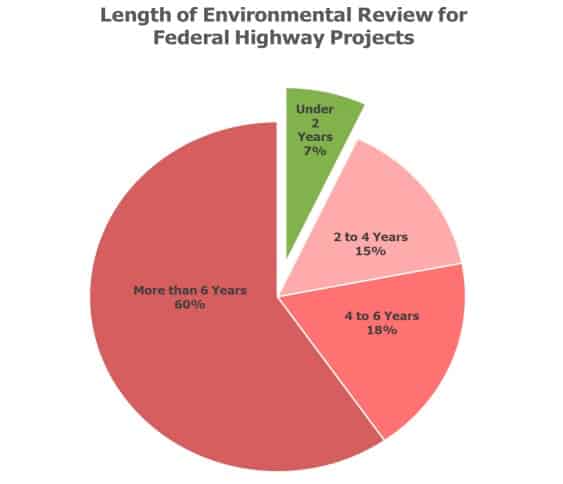The first major overhaul of federal environmental review regulations will dramatically reduce the permitting time for infrastructure projects, according to the Trump administration.
The Council on Environmental Quality (CEQ), an office within the White House, announced on Thursday a proposed rule revising the National Environmental Policy Act (NEPA). The proposal is scheduled to be formally published on Friday for a comment period ending March 10.
NEPA, which was signed into law in 1970, has become outdated and therefore has “slowed and impeded” needed infrastructure, according to CEQ. It asserted that the environmental impact statement (EIS) process for federal highway projects has averaged over seven years to complete, with many taking a decade or more.
By contrast, the proposed changes would establish time limits of two years for an EIS and one year to complete an environmental assessment.
“Over the past 40 years, NEPA has been used as a tool to slow or completely kill important infrastructure projects across the country,” said Russ Vought, acting director of the Office of Management and Budget. “Our administration continues to uphold environmental standards while streamlining the permitting process and removing frivolous litigation. No American city should be waiting over 30 years for a better highway because NEPA has their infrastructure project held up in unnecessary paperwork.”
U.S. Department of Transportation Secretary Elaine Chao called the proposal “common-sense reforms” to streamline environmental reviews that will “accelerate the construction of much needed roads, bridges, transit, railroad and port projects to alleviate congestion and improve the quality of life for communities across the country.”
Other key elements of the proposed rule that would simplify and accelerate the NEPA process include:
- Require joint schedules, a single EIS, and a single record of decision (ROD), where appropriate, for EISs involving multiple agencies
- Strengthen the role of the lead agency and require senior agency officials to timely resolve disputes to avoid delays
- Specify presumptive page limits
- Promote use of modern technologies for information sharing and public outreach
- Simplify the definition of environmental “effects” and clarify that effects must be reasonably foreseeable and have a reasonably close causal relationship to the proposed action
- State that analysis of cumulative effects is not required under NEPA
- Clarify that “reasonable alternatives” requiring consideration must be technically and economically feasible

“We think this is a very significant rulemaking,” Nick Goldstein, VP of regulatory and legal issues for the American Road & Transportation Builders Association (ARTBA), told FreightWaves. “ARTBA for a long time has had streamlining the environmental review process as a top priority, and this goes a long way toward doing that.”
Goldstein said that aiming for a two-year timeframe for an environmental review is probably the biggest aspirational reform, along with changes strengthening the role of a lead agency to be in charge of the process.
“Instead of having numerous agencies conducting reviews on several schedules, having one that acts as a lead can enforce the scheduling process on others,” he said. “Also, having a single document that all agencies contribute to rather than multiple documents will simplify the approach so that we’re not buried under a mountain of paperwork.”
ARTBA President Dave Bauer, who was at the White House for the rulemaking announcement by President Trump, emphasized that the full effects of the reforms will not be realized until Congress addresses a permanent revenue solution for the Highway Trust Fund and passes a new highway investment bill.
“The best next step is for Congress to approve a robust, multiyear transportation infrastructure investment bill that Republicans, Democrats and the president have been calling for since the 2016 elections,” Bauer said.







